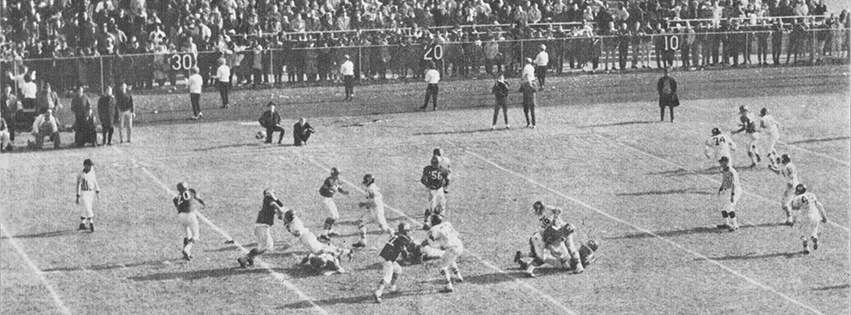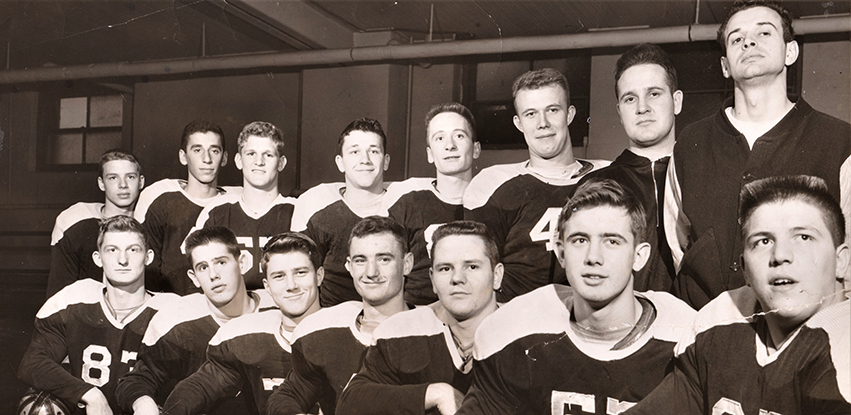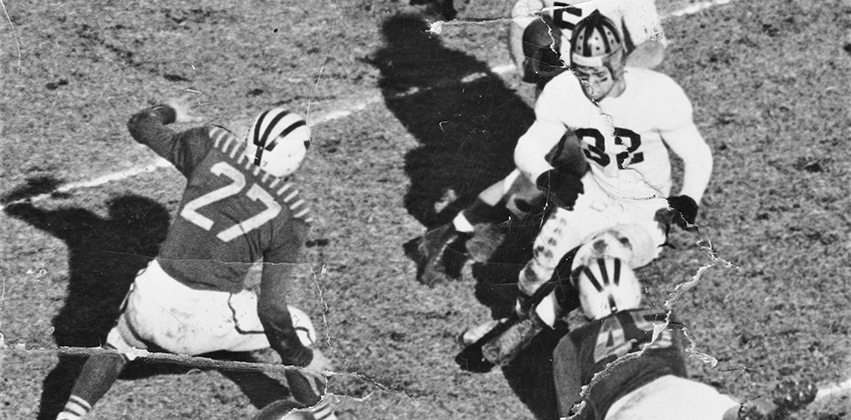
When area families sit down for their Thanksgiving dinner this November, some of the over-60 folks may recall Peoria’s annual Turkey Day football games—which began in 1915 and came to an end in 1973.
The Beginning
Two years after Manual High School opened in 1909, Manual and Peoria High School (or “Central”) played their first football game. The competition was always very intense, and a major riot erupted in 1914 over a touchdown by Central’s Louie Neumiller, who was the student body president and a future president of Caterpillar.
The brawl involved both players and spectators, and it took police 30 minutes to restore order. As a result, all athletic competition was declared “over” between the only two public high schools in Peoria. The following year, a “Peace Conference” was called at Peoria City Hall, where it was decided the two schools would resume athletic competition. The first competitive event would be a Thanksgiving football game. And with that, the Turkey Day Era was born.
That first Turkey Day game was played in 1915 on the Bradley University campus before a capacity crowd of 5,000 fans. It was reported that the noisy crowd could be heard all over the hilltop. Each year there were a variety of student activities associated with the games, including pep assemblies, bonfires and a Main Street “hobo” parade. The popularity of the event grew even larger when the games moved to the new Peoria Stadium.
Move to the Stadium
The Peoria “Fairgrounds” opened in 1895 with a one-mile horse track, ornamental horse barns, exhibition buildings and a dining hall under the grandstand. The Peoria School District purchased the fairgrounds in 1935 and work began to reconfigure it for high school sports. One major project was the construction of concrete bleachers by the federal Works Progress Administration, and there remains a 4x6-inch plaque mounted on the bleachers to recognize the WPA’s work.
When this extensive work was completed, a dedication program involving state and local dignitaries was staged before kickoff of the 1939 Turkey Day game. It was a clear, 27 degree day for that first stadium game, and 7,500 people filled the grandstand and new bleachers. Many also stood shoulder to shoulder around the fence encircling the field.

The Event
The annual Turkey Day games evolved into more than a football game; it became an annual reunion for many Peorians. School alumni, students on college break, servicemen home on leave, and folks in town visiting family included the Turkey Day game in their Thanksgiving plans—an ideal way to renew old friendships.
During its 59-year span, there were 73 Turkey Day games in Peoria. Central and Manual played 59 morning games between 1915 and 1973, while Woodruff and Spalding played 14 afternoon games between 1939 and 1952. The individual games drew crowds of 6,000 to 10,000—and a record 11,500 spectators attended the 1960 game. The variable November weather was often a memorable element, with one third of the games being played on a snow-covered field. The temperatures ranged from a balmy 65 degrees to a few times when it dipped below zero.

The People
Over the span of this era, 5,000 players suited up for the Turkey Day games, while thousands of band members, cheerleaders, coaches and officials remember being a part of the festivities. The Thanksgiving game marked the end of the high school football season, and most players never wore shoulder pads again. However, several went on to play major college football—including Ken Sutter, Billy Harper and Brock Hessing—while five played professional football: Howard Maple, Dick Jamieson, Earl Gant, Bob Swisher and Bob Judd.
There is also an endless list of notable Peorians who suited up for the Turkey Day games, including Pete Vonachan, Joe Trefzger, Jerry Klein, Ed Dwyer, Walt Durdle, Gary Leonard, Pete Margetis and Gene Petty. Peoria mayors Bob Morgan (Central) and Eugene Leiter (Manual) lined up across from one another in the 1928 game.
Each November, a reunion of 200 to 300 former Turkey Day players allows them to renew their friendships. Players who once banged heads on the field now greet their former opponents with friendly handshakes and celebrate their longevity and memories. The state playoff caused the end of the Turkey Day Era and continue to provide lifelong memories for today’s students. However, none are more meaningful than those involved in Peoria’s Turkey Day Era. PM
Robert L. Sulaski is the author of 59 Years of Drumsticks and Pigskins: The History of Peoria’s Thanksgiving Football Games. He was co-captain of the 1952 Woodruff football team that played in the last Woodruff-Spalding Turkey Day game.
- Log in to post comments

